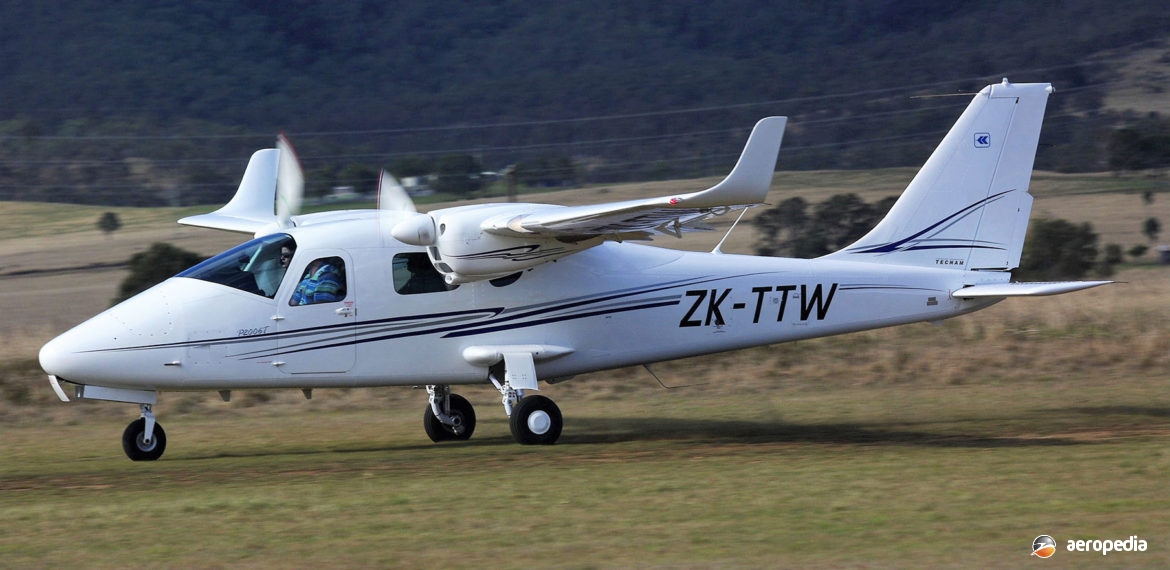Photograph:
Tecnam P2006T ZK-TTW (c/n 20) at Watts Bridge, QLD in August 2010 (David C Eyre)
Country of origin:
Italy
Description:
Light twin-engine transport
Power Plant:
Two 73 kw (98 hp) Rotax 912S four-cylinder horizontally-opposed liquid-and-air-cooled engine
Specifications:
- Wingspan: 10.6 m (34 ft 8 in)
- Length: 8.66 m (28 ft 4 in)
- Height: 2.85 m (9 ft 4 in)
- Wing area: 14.4 m² (155 sq ft)
- Max speed: 283 km/h (176 mph)
- Cruising speed at 75% power at 2,134 m (7,000 ft): 272 km/h (169 mph)
- Cruising speed at 65% power at 2,743 m (9,000 ft): 261 km/h (162 mph)
- Stalling speed flaps up: 99 km/h (62 mph)
- Stalling speed flaps down: 89 km/h (55 mph)
- Rate of climb at sea level: 415 m/min (1,360 ft/min)
- Range at 75% power cruise with 30 mins reserve: 1,130 km (702 miles)
- Range at 65% power cruise with 30 mins reserve: 1,315 km (817 miles)
- Service ceiling: 2,040 m (6,690 ft)
- Take-off roll: 225 m (738 ft)
- Landing roll: 340 m (1,115 ft)
- Empty weight: 640 kg (1,411 lb)
- Useful load: 460 kg (1,014 lb)
- Baggage allowance: 60 kg (132 lb)
- Loaded weight: 1,100 kg (2,425 lb)
History:
The P2006T was the first entry by the Tecnam company in Italy to produce a cheap twin-engine light aircraft. Of all metal construction, it was fitted with two Rotax 912S engines, was of high-wing configuration, and had a fully retractable tricycle undercarriage. A new facility was built next to the original facility at Capua to produce the type. The prototype (I-TETW) first flew in September 2007, the second on 9 June 2008. The aircraft has a robust but light airframe which produces a good payload to total weight ratio. By November 2007 orders for 32 had been received. It was first shown to the public at Aero 2007 at Friedrichshafen in Germany and it received European certification in late 2008 .
The type has been popular with aero clubs and flying schools as a cheap to operate and maintain light twin. It has been described as a “genuinely game-changing aircraft, melding twin-engine safety, Rotax frugality and Italian style in a revolutionary aircraft that has attractive looks, handling and good operating economics.” It was FAR 33 certified and when put into production was the only twin-engine aircraft permitted to operate on automotive fuel.
The retractable undercarriage was operated by a reversible electric pump, the main undercarriage having a trailing-link suspension, and was constructed from high-strength aluminium alloys and high tensile steel, with oleo-pneumatic shock absorption. The twin-engine configuration gave it the ability to travel long-distances over water and inhospitable terrain, each engine being equipped with a mechanically driven fuel pump and an electric back-up pump. Luggage could be carried in a 350 litre (12 cub ft) compartment. It was designed for business and pleasure, as well as twin-engine training. Operations from grass strips were within the aircraft’s operating profile.
The first example of the P2006T to be imported to this region arrived in New Zealand for the local distributor early in 2010, becoming ZK-TZY and being delivered to the first New Zealand customer, Izard Pacific Aviation of Taupo. This aircraft was imported to carry out the local certification process. A second aircraft arrived in mid 2010, becoming ZK-TTW, being used as a demonstrator, being flown across the Tasman and making a sale tour of Australia. This aircraft was later sold to Mabena Pty Ltd at Wagga Wagga, NSW and became VH-OWW.
An example of the type sold in Australia was for a Queensland cattleman, this aircraft being fitted for IFR with a Garmin 950 glass cockpit with synthetic vision, S-TEC autopilot , ST-360 Flight director and KC S55A HSI slaved compass system. A further machine became VH-SWJ³ (c/n 041) on 1 December 2010.
A further machine arrived in new Zealand in 2011, becoming ZK-TWN with Bay of Flight Aviation. An example became ZK-MTW (c/n 065) registered to the Middle Earth Flying School of Waharoa on 7 November 2011. And a further example became VH-OBZ (c/n 083) registered to BAe Systems Australia Ltd of Salisbury, SA on 21 May 2012. This was an Airborne technologies multi-mission aircraft. In November 2014 it was flown to New Zealand via Lord Howe Island and on arrival in Auckland became ZK-OBZ with Ardmore Aviation Services of Hong Kong.
In 2016 the aircraft was renamed the T2006A Twin and in July that year at a ceremony in Italy three examples (serials 7Q-40, 7Q-41, and 7Q-42) were delivered to the Italian Air Force. By early 2017 200 examples had been delivered, many being operated by flying schools in Europe.

